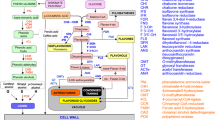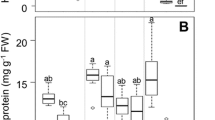Summary
Ecological trade-offs between growth, reproduction and both condensed tannins and cyanogenic glycosides were examined in Lotus corniculatus by correlating shoot (leaves and stem) size and reproductive output with chemical concentrations. We found that cyanide concentration was not related to shoot size, but that condensed tannin concentrations were positively correlated with shoot size; larger plants contained higher tannin concentrations. Both tannin and cyanide concentrations were depressed when plants produced fruits. Defense costs change as plants mature and begin to reproduce. These trade-offs indicate that cost of defense chemical production cannot be predicted merely on the basis of molecular size, composition or concentration.
Similar content being viewed by others
References
Abrahamson WG, Caswell H (1982) On the comparative allocation of biomass, energy and nutrients in plants. Ecology 63:982–991
Bernays EA (1981) Plant tannins and insect herbivores: An appraisal. Ecol Ent 6:353–360
Briggs MA (1990) Chemical Defense Production in Lotus corniculatus L. I. The effects of nitrogen source on growth, reproduction and defense. Oecologia 83:27–31
Cates RG (1975) The interface between slugs and wild ginger: Some evolutionary aspects. Ecology 56:391–400
Chew FS, Rodman JE (1979) Plant resources for chemical defense. In: Rosenthal GA, Janzen DH (eds), Herbivores: Their interaction with secondary plant metabolites. Academic Press, pp 271–308
Compton SJ, Jones CG (1985) Mechanisms of dye response and interference in the Bradford protein assay. Anal Biochem 151:369–374
Cooper-Driver GA, Swain T (1976) Cyanogenic polymorphism in bracken in relation to herbivore predation. Nature 20:604
Crawford-Sidebothum TJ (1972) The role of slugs and snails in the maintenance of the cyanogenesis polymorphism of Lotus corniculatus and Trifolium repens. Heredity 28:405–411
Feeny P (1976) Plant apparency and chemical defense. Rec Adv Phytochem 10:1–40
Goldstein WS, Spencer KC (1985) Inhibition of cyanogenesis by tannins. J Chem Ecol 11:847–858
Hagerman AE, Butler LG (1981) Specificity of the proanthocyanidin-protein interaction. J Biol Chem 256:4494–4497
Hickman JC, Pitelka LF (1975) Dry weight indicates energy allocation in ecological strategy analysis of plants. Oecologia 21:117–121
Jones DA (1962) Selective eating of the acyanogenic form of Lotus corniculatus L. by various animals. Nature 193:1109–1110
Jones DA (1966) On the polymorphism of cyanogenesis in Lotus corniculatus I. Selection by animals. Can J Genet Cytol 8:556–567
Jones DA (1968) Notes and comments on the polymorphism of cyanogenesis in Lotus corniculatus, L. II. Interaction with Trifolium repens L. Heredity 23:453–455
Jones DA (1970) On the polymorphism of cyanogenesis in Lotus corniculatus L. III. Some aspects of selection. Heredity 25:633–641
Jones WT, Anderson LB, Ross MD (1973) Bloat in cattle XXXIX: Detection of protein precipitants (flavolans) in legumes. N Z J Agric Res 16:441–446
Jones WT, Broadhurst RB, Lyttleton JW (1976) The condensed tannins of pasture legume species. Phytochem 15:1407–1409
Jones WT, Lyttleton JW (1971) Bloat in cattle XXXIV: A survey of legume forages that do and do not produce bloat. N Z J Agric Res 14:101–107
Lambert JL, Ramasamy J, Paukstelis JV (1975) Stable reagents for the colorimetric determination of cyanide by the modified Konig reactions. Anal Chem 47:916–918
Lorio PL (1986) Growth-differentiation balance: A basis for under-standing southern pine beetle-tree interactions. For Ecol Manage 14:259–273
Lyford SJ, Smart WWG, Bell TA (1967) Inhibition of rumen cellulose digestion by extracts of Sericea lespedeza. J Anim Sci 24:632–637
Mooney HA, Gulmon SL (1982) Constraints of leaf structure and function in reference to herbivory. BioScience 32:198–206
Morse RA (1958) The pollination of birdsfoot trefoil (Lotus corniculatus, L.) in New York State. In: Arnold JW (ed), Proc 10th International Congress of Ent, No 4. Montreal, Canada
Nartey F (1969) Studies on cassava, Manihot utilissima. II. Biosynthesis of asparagine-14C from 14C-labelled hydrogen cyanide and its relations with cyanogenesis. Physiol Plant 22:1085–1096
Oates J, Swain T, Zantovska J (1977) Chemical factors in the selection of food plants by Colubus monkey. Biochem Syst Ecol 5:317–321
Rhoades DF (1979) Ecological and evolutionary processes. In: Rosenthal GA, Janzen DH (eds), Herbivores: Their interaction with secondary plant metabolites. Academic Press, New York pp 1–55
Rhoades DF, Cates RG (1976) Toward a general theory of plant anti-herbivore chemistry. Rec Adv Phytochem 10:168–213
Rosenthal GA, Janzen DH (eds) (1979) Herbivores: Their interaction with secondary plant metabolites, p 718. Academic Press, New York
SAS (1982) User's Guide: Statistics SAS Institute, Cary NC
Schultz JC, Baldwin IT (1982) Oak leaf quality declines in response to defoliation by gypsy moth larvae. Science 217:149–151
Schultz JC, Baldwin IT, Nothnagle PJ (1981) Hemoglobin as a binding substrate in quantitative analysis of plant tannins. J Agric Food Chem 29:823–826
Seigler DS, Price PW (1976) Secondary compounds in plants: Primary functions. Am Nat 110:101–104
Swain T (1979) Tannins and lignins. In: Rosenthal GA, Janzen DH (eds), Herbivores: Their interactions with secondary plant metabolites. Academic Press, New York pp 657–682
Waghorn GC, Ulyatt MJ, John A, Fisher MT (1987) The effect of condensed tannins on the site of digestion of amino acids and other nutrients in sheep fed on Lotus corniculatus L. Br J Nutr 57:115–126
Woodruff BJ, Cantrell RP, Axtell JD, Butler LG (1982) Inheritance of tannin quality in sorghum. J Heredity 73:214–218
Zucker WV (1983) Tannins: Does structure determine function? An ecological perspective. Am Nat 121:335–365
Author information
Authors and Affiliations
Rights and permissions
About this article
Cite this article
Briggs, M.A., Schultz, J.C. Chemical defense production in Lotus corniculatus L. II. Trade-offs among growth, reproduction and defense. Oecologia 83, 32–37 (1990). https://doi.org/10.1007/BF00324630
Received:
Accepted:
Issue Date:
DOI: https://doi.org/10.1007/BF00324630




